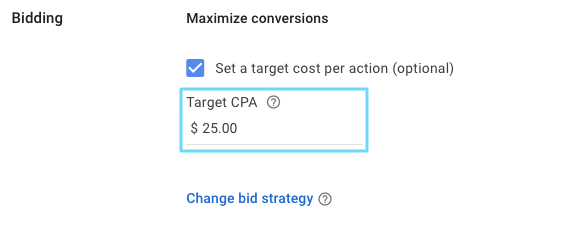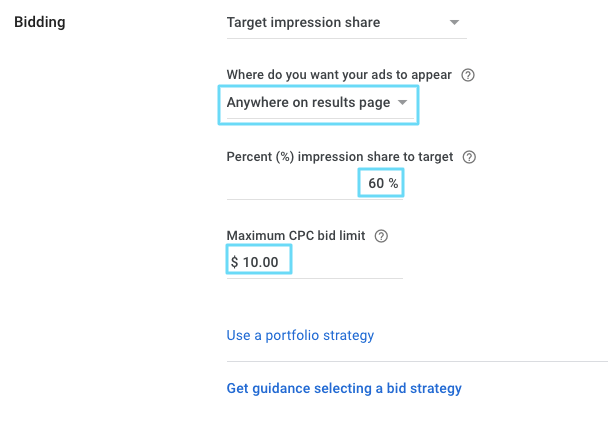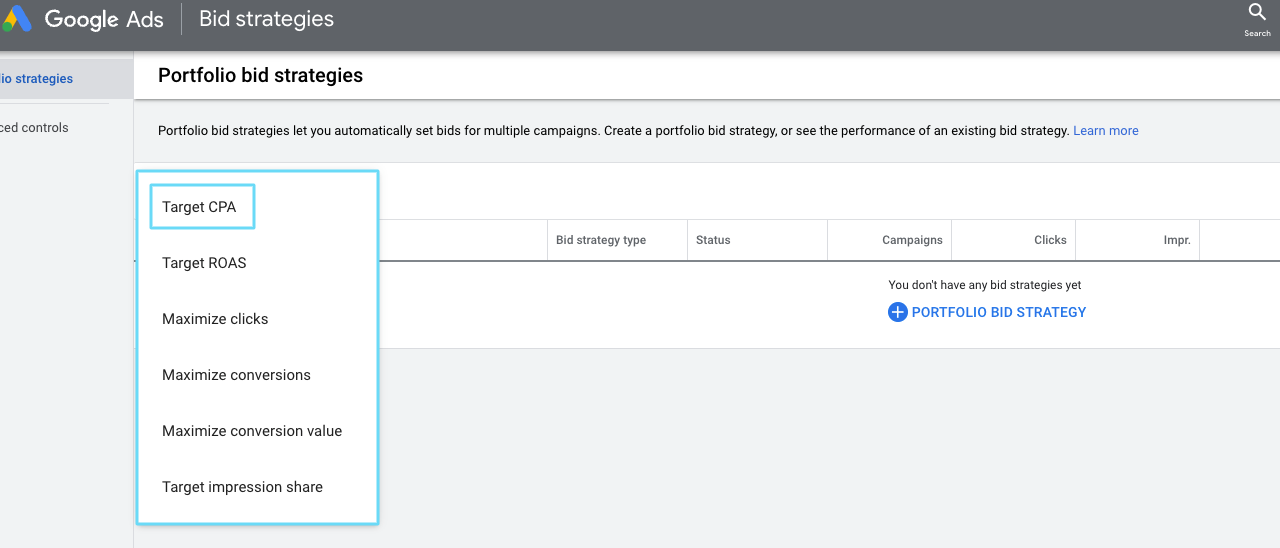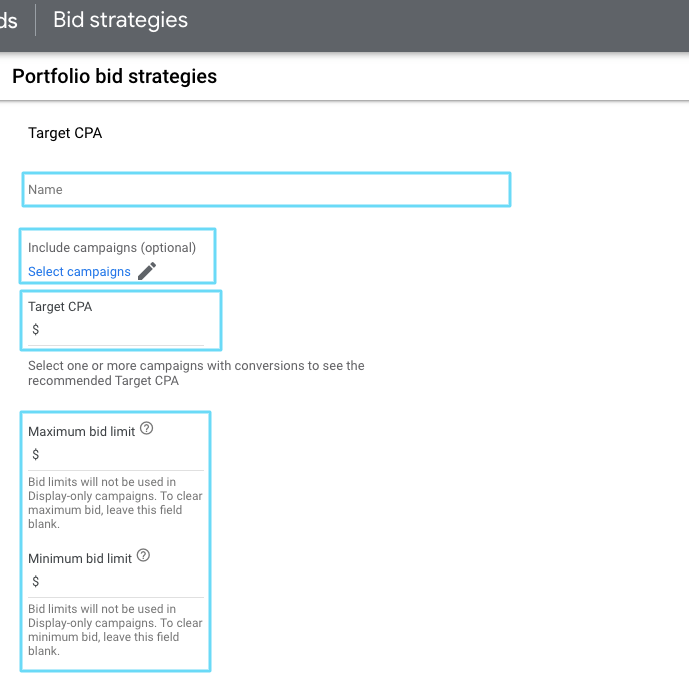Smart bidding strategies are letting Google Ads (formerly known as Google Adwords) do all the hard work optimizing bids for you. Google Smart Bidding is an advanced automated bidding strategy that utilizes machine learning algorithms to optimize bids for Google Ads campaigns.
It leverages a variety of signals such as device, location, time of day, re-marketing lists, and more to adjust bids in real-time, aiming to maximize conversions or conversion value while staying within a specified target cost per acquisition (CPA) or return on ad spend (ROAS).
So, does employing smart bidding mean Google completely takes over your role? Not exactly.What it really means is that you’re allowing Google to handle a specific aspect of your Google Ads management – one that’s, let’s be honest, both time-consuming and challenging. Keeping track of when, how, and how much to bid in each auction is a task best suited for robots. (But let’s keep that between us).
Google Automated & Smart Bidding Strategies
The bidding landscape is in a constant state of flux. With approximately 5.6 billion searches happening on Google every day, most of these searches trigger auctions behind the scenes to determine which ads will appear and in what order.
For us Google Ads enthusiasts, it’s practically impossible to monitor the myriad of searches that could be relevant to our campaigns and bid the optimal amount at the perfect moment for each one.
That’s where smart bidding comes into play, allowing the robots to take the reins.
Smart bidding vs. automated bidding
Now, it’s come to our attention that there are two terms circulating that some individuals often use interchangeably: smart bidding and automated bidding. Before we proceed, let’s clarify these distinctions.
While smart bidding and automated bidding are closely related, they aren’t precisely synonymous.
To simplify matters, consider automated bidding as the overarching term. Automated bidding strategies encompass any strategies that utilize machine learning to dynamically adjust your bids with the aim of achieving your objectives. In total, there are seven such strategies.
Nested within this category are smart bidding strategies. These are a specific subset of automated bidding strategies engineered to optimize either conversions or revenue. In total, there are five such strategies. Some may argue for four, but we’ll delve into the fifth strategy shortly.
Now that we’ve sorted out that distinction, let’s delve deeper into the details.
How does smart bidding work?
Before we proceed, it’s essential to note that if you’re not well-versed in the workings of bidding and auctions in general, or how ads appear within a Google search, it’s advisable to review the basics before continuing here. Otherwise, let’s dive in.
First and foremost, it’s crucial to understand that the bidding landscape on Google is incredibly dynamic. Consider this: you’re in a competitive arena with other marketers striving to stay ahead of the curve, just like you.
Keeping up with adjustments in keyword bids and ensuring optimal performance can be challenging. Google operates at such a rapid pace that it may feel like it’s constantly outpacing you, especially if you’re managing everything manually.
That said, opting for smart bidding signals to Google that you want it to handle bid adjustments for you at auction time, a process known as auction-time bidding. This is done in a manner specifically optimized for the goal you’re aiming to achieve, helping you keep pace with the ever-evolving landscape.
And that’s precisely what smart bidding is designed for.
With smart bidding, you’re informing Google Ads of the objectives you aim to accomplish, whether it’s increasing conversions, achieving a specific target cost per conversion (CPA), boosting revenue, or enhancing return on ad spend (ROAS).

With this information in hand, Google leverages your existing conversion data and combines it with various contextual signals gathered from each auction.
It takes into account your objective and adjusts bids automatically for searches that exhibit a higher probability of contributing to that objective. Conversely, it decreases bids for searches showing less intent towards achieving your goal.
For instance, if you’re utilizing the “maximize conversions” strategy and Google identifies from your historical conversion data that individuals searching on mobile devices in Florida around 8 pm are more prone to convert, it might increase bids for similar searches accordingly.
Smart bidding vs. manual bidding
If you opt for manual bidding instead of smart bidding, you have the ability to set bids at the keyword level precisely to ensure your ad appears on the first page of search results or even at the top of the page. This approach gives you a high level of control over your bidding strategy.

Some individuals prefer having this level of control. Having been among those individuals, I understand the appeal. You have a clear grasp of your budget, and you can regulate how much you allocate to each keyword, effectively managing your cost per click (CPC).
However, there’s a significant caveat… You’re not a machine.
You lack access to the plethora of contextual signals that smart bidding utilizes to make real-time inferences during auctions. You’re not adjusting your bids based on the intent of each searcher. Instead, you’re merely controlling bids at a surface level, which can result in significant inefficiencies, even if your CPCs are kept low.
Nevertheless, there are situations where manual bidding is appropriate. Not every campaign or account may thrive on smart bidding, particularly if there isn’t enough historical conversion data for Google to analyze.
As a general guideline, we recommend starting with manual bidding or enhanced CPC (eCPC) for new accounts, allowing you to gather conversion data over time.
Even for established accounts, we often suggest beginning new campaigns with manual bidding or eCPC, despite having past conversion data available.
While Google asserts that smart bidding strategies leverage historical data from the entire account to optimize bids, our experience suggests that new campaigns within established accounts sometimes encounter challenges in adopting smart bidding immediately.
What are the benefits of smart bidding?
Smart bidding was developed to simplify the lives of advertisers by harnessing the power of machine learning to enhance results. It’s no wonder why numerous digital marketing professionals are embracing it.
To ensure you understand the reasons for considering joining the trend, let’s explore some of the key benefits of implementing smart bidding.
You’re letting Google go for gold on your PPC goals
When you’re manually setting your bids, you’re doing so based on objective factors, but you may not always be fully aware of the intricate real-time dynamics that can influence your success.
As discussed previously, with smart bidding, Google’s algorithm utilizes extensive data from your account and user behaviors related to your keywords. Consequently, it automatically identifies which clicks are more likely to lead to goal completions, offering a significant advantage.
Allocating more of your budget towards achieving goals translates to reduced budget wastage. And that’s a benefit everyone can appreciate.
Set it and forget it (mostly)
Keep in mind, adopting smart bidding doesn’t equate to jetting off to the Bahamas and abandoning your Google Ads account forever. However, it does liberate you from the constant need to micromanage bids at the keyword level.
According to a recent BCG study, a staggering 80% of digital marketers’ time is consumed by manual tasks such as bidding, leaving only 20% for strategic endeavors. That’s a significant chunk of wasted time, wouldn’t you agree?
By freeing yourself from bid babysitting, you gain more time to focus on strategies and impactful changes that can enhance performance, such as upgrading that landing page you’ve been meaning to work on.
Google makes really intuitive decisions
Google’s extensive knowledge about its users is a concept we’re all quite familiar with, whether we like it or not. Consider this: Gmail boasts over 1.8 billion users worldwide, while Google Chrome is the preferred browser for 2.65 billion users. And what ties all this user data together? Yes, you guessed it – Google Ads.
The name “smart bidding” isn’t arbitrary. Google possesses a vast repository of user data, allowing it to analyze factors such as location, browser, device, and more in real-time during auctions. Additionally, it can leverage data from Search Partner sites to gauge the likelihood of conversion for your ads in specific placements.
When combined with insights into the behavior of users who have previously converted on your ads, Google’s ability to infer user data and context at the time of auction enables it to optimize bids in real-time for high-value searches. This level of optimization far surpasses what can be achieved through manual bidding.
What are the cons of smart bidding?
There’s always a downside, isn’t there? Even machines have their imperfections. We’re reminded of this whenever Siri interjects into our conversations uninvited, informing us she “didn’t catch that.”
However, the drawbacks of smart bidding aren’t necessarily deal-breakers. Rather, they’re considerations to bear in mind as you observe the changes in your accounts with smart bidding.
Without further delay…
It’s not exactly always cheap
Losing control over your bids isn’t always ideal, let’s face it. Certain industries are considerably more costly to advertise in than others, and the tech and software sectors are prime examples.

When you entrust Google to determine your bids at auction time, its objective is to achieve your goals efficiently.
This could involve bidding higher on individuals displaying specific signals and bidding lower on those who don’t. It may also entail increasing bids to remain competitive if targeting a particularly valuable audience.
None of the five smart bidding strategies offer the option to set a bid ceiling (the maximum cost per click you’re willing to bid in an auction) on a per-campaign basis. Therefore, it’s crucial to monitor your costs and take steps to reduce your Cost Per Click (CPC) if necessary.
Costs can escalate rapidly, especially during the learning phase of the strategy. This leads to my next point.
Meet “the learning phase”
In an ideal scenario, you’d implement a smart bidding strategy, and it would seamlessly execute from day one. After all, isn’t Google supposed to be omniscient?
Not quite. The system isn’t flawless. While it can initially glean insights about users likely to convert and leverage them, smart bidding requires time to refine its decisions, learning from both successes and failures.
Google estimates the average learning period to be around a week. However, this can vary depending on the individual account, with more historical data typically leading to shorter learning periods.
I’ve encountered accounts where the learning period lasted only a few days, while others persisted for up to four weeks before the strategy fully optimized. There were also instances where the learning period seemed indefinite.
The learning period serves as a critical juncture. If your key metrics don’t meet expectations during smart bidding testing, it’s essential to assess how much time you’re willing to afford Google to learn before considering alternative strategies.
Google doesn’t have ALL the answers
Google possesses extensive knowledge, but even sophisticated machine learning has its constraints.
Consider a scenario where you’re targeting a rare and niche conversion without much historical data to support it. Google Ads operates based on the intelligence provided by your data. If there’s insufficient data available, even Google may struggle to make informed bid optimizations.
Admittedly, there are instances where Google Ads may still bid on searches and allocate funds despite predominantly uninformed decisions.
Furthermore, it’s essential to acknowledge that while a smart bidding strategy may generate numerous leads, refining the quality of these leads, especially in B2B advertising, can be challenging.
Google Ads doesn’t inherently recognize that a lead from an individual with a fake email address holds less value than a lead from a high-ranking executive at a prominent company.
Enhancing the quality of leads, rather than merely focusing on quantity, requires additional effort. This is where Offline Conversion Tracking proves invaluable, as it can provide qualifying data about your leads post-engagement.
The 5 types of smart bidding strategies
Google is in a constant state of evolution, leading to the introduction of new smart bidding strategies and adjustments to existing ones. Over time, our bidding choices are bound to become increasingly sophisticated.
Currently, it has been announced that target CPA and target ROAS bidding strategies are set to be phased out. Many accounts have already seen their disappearance.
Instead, users will have the option to set target CPA and target ROAS goals within the maximize conversions and maximize conversion value strategies, respectively. According to Google, this should function similarly to the individual target CPA and target ROAS strategies that were originally available.
With that said, the smart bidding strategies currently at your disposal include:
Maximize conversions
The primary objective of this strategy is to maximize the number of conversions within your allocated budget, thereby significantly enhancing your conversion rate. These conversions can encompass various valuable actions you’re tracking, such as phone calls, form submissions, purchases, or a combination of these.
It’s important to note a significant caveat: while you might be concerned about your cost per acquisition (CPA) or return on ad spend (ROAS), this strategy does not prioritize these metrics. Its sole aim is to maximize the number of conversions achievable within your budget.
However, due to its focus on maximizing conversions, this strategy can potentially incur higher costs. Therefore, it’s crucial to monitor your cost per click (CPC) and ensure that your spending remains within your daily budget.
If the feature is available to you, you can opt to set a target CPA goal for this strategy to help control your conversion costs.
We recently implemented this approach for a client with a substantial amount of conversion data and observed remarkable improvements across all campaigns. Particularly noteworthy was a 640.81% increase in conversions and an 87.53% decrease in CPA.

Target cost per acquisition (tCPA)
This strategy aims to achieve or surpass your cost per acquisition (CPA) goal while staying within your daily budget. To implement this, you’ll need to establish a target CPA goal for the strategy to pursue.
Ideally, set a target CPA close to your campaign’s current 30-day CPA average and adjust gradually from there, even if it differs from your ultimate CPA goal. Google may even suggest this average when configuring the strategy. Begin with a reasonable target and gradually decrease it over time.
We recently tested this approach with our client, Osmosis, resulting in a 32% increase in conversions, a 22% rise in conversion rate, and a 16% reduction in CPA.
Employing target CPA bidding on a campaign-by-campaign basis has the potential for significant success, but you can further enhance your results by leveraging our secret weapon, which we’ll discuss later.
When target CPA bidding is phased out, you can achieve similar strategic outcomes by setting a CPA target goal within the maximize conversions bidding strategy.
Target return on ad spend (tROAS)
This strategy aims to achieve or exceed your return on ad spend (ROAS) objectives while staying within your daily budget. Your ROAS is calculated by dividing the conversion value (revenue) gained from ads by the amount spent on advertising.
Ultimately, target ROAS strives to maximize your profit relative to your ad spend. While this may result in increased overall conversion value, it’s not guaranteed, but it’s crucial to understand.
When target ROAS bidding is phased out, you can achieve similar strategic outcomes by setting a ROAS target within the maximize conversion value bidding strategy.
It’s important to note that the ROAS metric is expressed as a number. For example, if your ROAS goal is 4, you aim to generate $4 in revenue for every $1 spent on ads. However, your bid strategy’s ROAS goal is represented as a percentage. Therefore, setting a target ROAS goal of 400% means you aim to generate $4 in revenue for every $1 spent, which corresponds to a ROAS goal of 4.

Similar to other strategies, it’s advisable to set your initial ROAS goal close to your average ROAS over the last 30 days and gradually raise it over time.
Maximize conversion value
This strategy aims to extract the maximum conversion value (revenue) from your daily budget, prioritizing achieving the highest dollar amount of conversion value possible.
Unlike the target ROAS strategy mentioned earlier, which focuses on achieving a specific return on ad spend (ROAS), the maximize conversion value strategy concentrates solely on maximizing the revenue generated, without necessarily improving ROAS.
While this approach may result in higher revenue figures, it could also lead to higher costs, potentially resulting in a lower ROAS and reduced actual profit.
To mitigate this, if the feature is available, you can set a target ROAS goal within this strategy to ensure a more favorable return on investment.
Enhanced CPC (ECPC)
At first glance, numerous advertisers may not view enhanced CPC as a smart bidding strategy since it’s merely a setting implemented within manual bidding.

However…Google actually does consider it a kind of smart bidding:
“Available as an optional feature with Manual CPC bidding, ECPC is a form of Smart Bidding that uses a wide range of auction-time signals such as browser, location, and time of day to tailor bids to the unique context of each search, but not to the full extent of other Smart Bidding strategies, such as Target CPA and Target ROAS.”
As mentioned, we often initiate new accounts and campaigns with manual bidding, typically enabling Enhanced Cost Per Click (ECPC) in the process.
This ensures that Google actively seeks opportunities to exceed our specified bids for a higher likelihood of conversion. Unlike other smart bidding strategies, ECPC appears to perform more effectively when utilized from the outset in new accounts or campaigns.
Beginning with ECPC enables you to accumulate conversion data and progress towards implementing a smart bidding strategy, rather than adopting it blindly. It’s essential to remember that the more conversion data you have, the better equipped smart bidding is to learn and optimize.
2 more automated bidding strategies to try
Within the realm of automated bidding, there exist two additional strategies that do not fall under the smart bidding category.
Although these strategies leverage machine learning to attain your objectives, the goals set with them are not specifically aimed at increasing conversions or revenue.
However, this doesn’t imply that these strategies are unable to drive more conversions when implemented. In fact, one of our clients experienced a 300% increase in conversions and a 64% decrease in CPA within a span of 3 weeks after switching to the maximize clicks strategy for one of their campaigns.

However, these bidding strategies are not explicitly tailored to pursue conversions. Therefore, when we observe an increase in conversions, it’s considered an additional benefit aligned with the strategy’s original intent. (And it certainly works out well for us, so there are no complaints.)
Now, let’s explore these strategies in greater detail.
Maximize clicks
This strategy aims to maximize the number of clicks obtained within your budget. It’s particularly effective for driving traffic to your website, reducing cost per click (CPC), and enhancing your click-through rate (CTR). However, its primary focus is not on generating conversions.
Interestingly, higher CTR, which can result from maximize clicks, sometimes leads to an increase in conversions.
Moreover, maximize clicks may also increase impression share, which can indirectly contribute to higher conversion rates.
A notable feature of Maximize Clicks, especially for cost-conscious users, is the ability to set a maximum CPC bid or bid ceiling. This allows you to specify the maximum amount you’re willing to pay for a click. However, it’s essential to note that any device or location bid adjustments applied may occasionally surpass your bid ceiling.

Another advantage of this strategy is that the learning period tends to be brief, as acquiring clicks is generally easier than obtaining conversions.
While it’s not primarily focused on conversions, it still offers its own benefits.
Target Impression Share (IS)
The objective of this strategy is to achieve or surpass your target impression share goal while adhering to your daily budget. Your impression share represents the percentage of impressions you received divided by the total number of impressions you were eligible to receive.
With this strategy, you have the option to target various aspects. You can aim for an overall impression share (anywhere on the page), target top of page impression share (at the top of the page), or target absolute top impression share (in the first position on the page).

Similarly, this strategy does not aim to drive conversions directly. However, it’s worth noting that low impression share in an account often correlates with low conversion rates.
Therefore, if your impression share is notably low and your conversion rates are struggling, employing this strategy can help improve impression share and potentially enhance conversion rates as a secondary effect.
To implement this strategy effectively, it’s essential to set a realistic impression share goal based on your average impression share over the last 30 days and gradually work towards increasing it.
Additionally, we highly recommend setting a maximum CPC bid limit. Sometimes, CPCs can escalate when attempting to boost impression share, particularly if targeting the absolute top position.
How do you know which automated bidding strategy to use?
In short: It depends.
That’s probably not the answer you were hoping for, but let me provide some context before you start throwing things at me.
Your goals should be the driving force behind your choice of bidding strategy. So, you’ll need to determine what matters most to your business and what aligns best with your current account status.
For instance, if you’re running an eCommerce business and your main objective is to maximize revenue while minimizing spending, target ROAS bidding might be worth a shot.
On the other hand, if your primary goal is to maximize conversions, regardless of the cost, you might consider giving maximize conversions bidding a try.
Alternatively, if you’re aiming to reduce your cost per acquisition to make the most out of your budget, target CPA bidding could be the way to go.
But here’s the kicker: your data plays a crucial role in the success of these strategies.
Target CPA bidding might seem like a fantastic idea, but if you set a target CPA significantly lower than your account’s historical average or if your budget isn’t sufficient, you might end up hindering your performance.
Ideally, for tCPA bidding to have a fighting chance, your daily campaign budget should be at least twice your CPA goal. So, if your daily budget is $40 and your CPA goal, based on your campaign average, is $300, you can see why that wouldn’t work out.
Similarly, while maximize conversions bidding might sound promising, if you lack conversion data, you could risk stalling performance or inadvertently giving Google Ads free rein to bid without clear direction.
Ultimately, your choice of strategy hinges on your business priorities. Define those first, then assess your account’s current state to determine what’s realistically achievable.
Is smart bidding the only magic pill you’ll need?
Wouldn’t that be fantastic? Unfortunately, there’s no such thing as a one-size-fits-all solution in advertising. Achieving account health and overall success involves juggling multiple factors, such as accurate conversion tracking, Single Keyword Ad Groups (SKAGs), and targeting the right audience, just to name a few.
Moreover, most strategies aimed at boosting conversions often require a touch of remarketing to capture missed opportunities that would otherwise slip through the cracks.
While smart bidding strategies have undoubtedly made significant strides in enhancing performance for many accounts, they don’t operate in isolation, nor are they the ultimate remedy for every account.
The secret weapon: portfolio bidding strategies
As pledged, it’s now time to unveil our secret weapon.
There’s one final aspect every advertiser should be cognizant of, and that’s portfolio bidding strategies.
“Portfolio bid strategies are automated, goal-driven bid strategies that help you optimize bids across multiple campaigns.”
For instance, rather than employing individual tCPA bid strategies for each campaign, you can establish a single tCPA bid strategy that is shared across all your campaigns.
This is particularly advantageous if your campaigns share the same CPA goals. By consolidating your smart bidding strategy in this manner, you provide the algorithm with a larger pool of aggregate data to learn from. This, in turn, grants your campaigns an added advantage: experience. Struggling through the learning phase? Well, now you’ve overcome it.
To get a more detailed look at portfolio bidding, check this out.
For now, we’ll give you a quick rundown on how to set one up.
Setting up your portfolio bidding strategy
Here’s an ideal scenario for implementing a portfolio bidding strategy:
Imagine you’re managing an online college’s Google Ads account, where campaigns are segmented by various types of diploma courses. However, individually, none of these campaigns have seen significant success with smart bidding strategies.
If all the campaigns share the same CPA goal, then employing a portfolio bidding strategy can provide a much-needed boost to the algorithm.
Getting started with this approach is straightforward. Simply follow these steps:
1. Under “Shared Library,” go to “Bid Strategies”
Navigate to the top right corner of Google Ads and click on “Tools and Settings.” Locate the section labeled “Shared Library” and click on “Bid Strategies.”

2. Create a new portfolio bidding strategy
Click on the blue “+” button to initiate the creation of a new portfolio bidding strategy. Next, choose the desired strategy you wish to implement.
For this demonstration, let’s opt for target CPA.
While target CPA bidding may be phased out on a campaign-by-campaign basis, Google has indicated that its availability within portfolio bidding may persist for a longer duration.

3. Establish your settings
Enter the name of your strategy and choose the campaigns to which you want to apply it. If your campaigns haven’t been created or aren’t ready yet, you can skip this step and apply the strategy in your campaign settings later.
Next, specify your target CPA.
Then, navigate to “Advanced Settings.” Here, you can set a maximum CPC limit, which can significantly aid in cost control with the tCPA strategy. This feature isn’t available when using tCPA on a campaign-by-campaign basis; it’s exclusive to tCPA in portfolio bidding.
While you have the option to set a minimum CPC limit as well, we typically refrain from doing so.

And there you have it. Your campaigns can now be grouped together with the same CPA goals instead of dividing bidding strategies for each campaign, resulting in quicker learning for you.
Now that you’re armed with our secret weapon, there’s only one thing left to do – deploy it.
Takeaways
If you’re currently handling manual bidding, it’s likely consuming more of your time than you’d prefer. You probably have a plethora of other tasks that you’d rather be focusing on. Moreover, bid adjustments happen so swiftly that you might feel constantly playing catch-up.
Now that you’re well-versed in the realm of automated and smart bidding, understanding its intricacies, advantages, and drawbacks, and you’ve mapped out your options.
Keep in mind, determining whether smart bidding is truly the best fit for your requirements will hinge on your objectives and the condition of your account. It’s not a decision to rush into blindly.
However, once you’ve identified the strategy you wish to pursue, the next step is to test, test, test. Once you’ve mastered it, forge ahead and further enhance your conversion-boosting prowess with our blog.
 seolounge
seolounge



